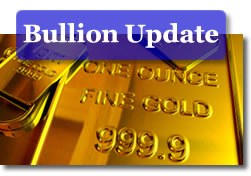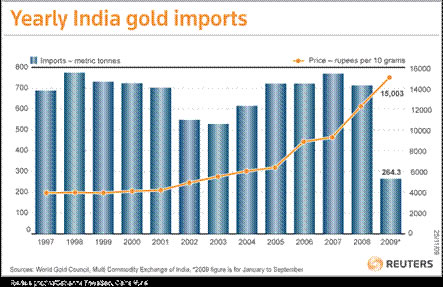 New York gold futures advanced modestly on Tuesday as a seesawing US dollar eventually tilted stronger toward the end of the trading day, curbing the yellow metal’s appeal and cutting into its earlier gains. Silver shined the brightest, jumping 1.9 percent. Platinum rose 0.9 percent.
New York gold futures advanced modestly on Tuesday as a seesawing US dollar eventually tilted stronger toward the end of the trading day, curbing the yellow metal’s appeal and cutting into its earlier gains. Silver shined the brightest, jumping 1.9 percent. Platinum rose 0.9 percent.
In other markets, crude oil advanced for the ninth consecutive session while US stocks ended mixed with narrow movement.
New York precious metal figures follow:
-
Gold for February delivery climbed 40 cents to $1,118.70 an ounce. It ranged from $1,118.10 to $1,129.60.
-
Silver for March delivery advanced 33.7 cents to close at $17.800 an ounce. It ranged from $17.510 to $17.885.
- April platinum rose $13.90 to end at $1,537.80 an ounce. It ranged from $1,520.60 to $1,545.00.
In PM London bullion, the benchmark gold price was fixed to $1,123.25 an ounce, which was an increase of $1.75 from Monday. Silver surged 40 cents to $17.570 an ounce. Platinum was settled at $1,518.00 an ounce, gaining $18.00.
Notable bullion quotes follow:
"The weak dollar and slow economic recovery will continue to enable gold to compete with other asset classes for the marginal investment dollar," Tom Pawlicki, an MF Global Inc. analyst in Chicago who predicted the price will climb to $1,350 this year, said on Bloomberg.
"Growing hopes for an economic recovery in the U.S. are boosting prices of industrial commodities, such as oil and platinum, and the strength of platinum has been supporting gold recently," Shuji Sugata, research team manager at Mitsubishi Corp
Futures Ltd, said on Reuters.
"Bullion prices built upon Monday’s gains as continued US dollar weakness was manifest during the overnight hours, and as risk appetite remained elevated among speculators for the second session of the new year," wrote Jon Nadler, senior analyst at Kitco Metals, Inc. "Although the greenback did not slip substantially beneath 77.35 on the trade weighted index, and did not get too far away from 1.444 against the European common currency, commodities continued to receive heaps of cuddly attention from the speculative crowd." [Read Nadler’s full commentary.]
Gold, considered a hedge during times of high inflation and economic uncertainty, tends to follow oil and move opposite to the U.S. dollar. A rising greenback makes dollar-denominated commodities, like bullion, more expensive for holders of other world currencies.
Oil and gasoline prices
Oil prices climbed for the ninth straight day on Tuesday. New York crude-oil for February delivery advanced 26 cents, or 0.3 percent, to $81.77 a barrel.
"Oil really got a boost from a string of upbeat manufacturing readings from the U.S., China and India," Toby Hassall, a research analyst at CWA Global Markets Pty in Sydney, said on Bloomberg. "It has been a cold winter across a lot of the Northern Hemisphere, which has boosted demand for heating fuels and is expected to draw down the ample distillate stockpiles."
The national average for regular unleaded gasoline moved up four-tenths of a cent to $2.667 a gallon, according to AAA fuel data. That is 5.9 cents higher than last week, 3.4 cents more than a month back, and 99.5 cents above the price of a year ago.
U.S. Stocks
U.S. stocks finished mixed "as investors weighed a seesawing dollar, a slew of auto sales and reports on pending home sale and factory orders," wrote Alexandra Twin of CNNMoney.
The Dow Jones industrial average declined 11.94 points, or 0.11 percent, to 10,572.02. The S&P 500 Index advanced 3.53 points, or 0.31 percent, to 1,136.52. The Nasdaq Composite Index rose 0.29 points, or 0.01 percent, to 2,308.71.
Gold, Silver, and Metals: Prices and Commentary – Jan. 5
by Jon Nadler, Kitco Metals Inc.
Good Day,
Bullion prices built upon Monday’s gains as continued US dollar weakness was manifest during the overnight hours, and as risk appetite remained elevated among speculators for the second session of the new year. Although the greenback did not slip substantially beneath 77.35 on the trade weighted index, and did not get too far away from 1.444 against the European common currency, commodities continued to receive heaps of cuddly attention from the speculative crowd. Crude oil rose another $.30 to reach $81.81 per barrel, while copper was still sitting atop a 16-month high price level.
Analysts at Belgium’s GoldEssential.com cited: "the weaker dollar as currently providing gold the necessary thrust, hand in hand with higher risk appetite and rallying equity markets." As well, they pointed to: "index rebalancing in favor of gold, have given sentiment a boost on the first trading days of the 2010." Optimism does not appear to be in short supply among risk-takers as 2010 gets underway, as they see at least several weeks more worth of opportunities to employ ultra-cheap dollars in their quest to try to make…more of the same (for themselves).
This morning’s New York spot precious metals prices showed additional gains in all but platinum. Gold opened with a $3.30 per ounce gain, quoted at $1124.20 per troy ounce, while silver added six cents to rise to $17.64 per ounce. Palladium gained four dollars to climb to $423.00 per ounce, rhodium rose $30 per ounce to $2490.00, and mild profit taking hit platinum prices which sank four dollars, to $1518.00 per ounce. The initial gains turned into small, profit-taking-induced losses by 9 AM New York time, with gold showing a $1.40 loss and dropping to $1119.50 per ounce, at last check.
There is resistance ahead for the February gold contract, first near the $1,130 mark, and then anywhere from $1,140.00 to $1,145.00 per ounce, a level from which the metal repeatedly turned away during December. Current support levels are seen around $1,118 an ounce and then $1,110 an ounce. The yellow metal may well attempt to extend its run towards the $1140 level, however, players will certainly be mindful not only of the release of the last FOMC meeting’s minutes tomorrow, but especially of the US payrolls data coming our way on Friday. A gain in jobs could derail this tire-smoking start to the new year.
The above-mentioned levels of risk-taking and optimism were aided this morning by news from Germany that the country’s unemployment levels unexpectedly fell in December. Such a decline reinforces the view that a global economic revival is underway, on the heels of various central banks’ largesse. Also helping fuel risk appetite this morning was the news that Greece may now borrow funds privately, through various banks before the end of this month.
The country recently saw its credit rating lowered by Standard & Poor’s, Fitch ratings, and Moody’s Investor Services, and is pedaling hard to come up with deficit-cutting plans, as well as alternative sources of financing (no ECB helping-hand on the horizon). Over in the Old World, inflation rates rose to 0.9% last month following a gain of 0.5% in November. However such price gains remain significantly below the ECB’s inflation targets and December’s spike was a largely attributable to rising energy costs, as compared to December of 2008.
So, where to, for the markets, from here on out? Certainly, at least as regards stock markets, there is an oft-cited school of thought which says that the first five trading days of the year have a pretty good record at predicting the market’s direction for the remainder of said year. Marc Hulbert over at Marketwatch does not agree with that metric, and observes that the markets’ likelihood of rising following a positive first week’s start is, statistically speaking, only four percentage points higher in an average year.
Mr. Hulbert believes that, in fact, the first five trading days of April and May could have better forecasting attributes than what is seen in January’s opening salvoes.
In the interim, the Bombay Bullion Association has yet to officially come out with its final 2009 gold imports tally, but provisional figures (estimates range from 200 to 300 tonnes) indicate that India’s gold imports may have fallen by possibly as much as 50% against 2008 import levels. A combination of poor weather and record high gold prices — but mainly the latter — were identified as the culprits behind such a severe slump.
A few metals analysts feel that India has already relinquished its spot as the top gold importer in the world, and that either the UAE, or China, may have overtaken the country in imports of the yellow metal last year. Extraordinary liquidity and apparently insatiable risk appetite in China has engendered a buying spree by that country across a wide range of commodities (and other assets as well).
The picture below, courtesy of the World Gold Council, illustrates the worrisome fall-off in Indian gold imports. We continue to believe that such a picture should be ringing some very loud alarm bells in the gold market. Such developments should be treated with at least the same degree of gravitas that the RBIs purchase of 200 tons of IMF gold prompted among some gold market observers late last year. We are talking the "bread-and-butter" of the gold market here, nothing less.

Happy Trading!
Jon Nadler
Senior Analyst
Kitco Metals Inc.
North America
Blog: http://www.kitco.com/ind/index.html#nadler
Check out other resources at Bullion Prices, Silver Coins Values and America the Beautiful Silver Bullion Coins.










